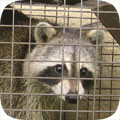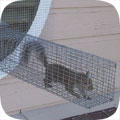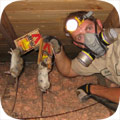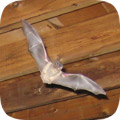- hammond@wildlifeanimalcontrol.com
Call 24/7 for a free quote:
985-520-0954
Hammond Wildlife Animal Control
Professional Wildlife Removal Company Servicing Hammond, LA
If you have a problem with wildlife in your Hammond home, your best option is to hire a company that specializes in Louisiana wildlife removal only. This is a specialty business, and regular pest control companies do not use the proper techniques to solve animal problems. I have spent many years reviewing Louisiana and Hammond, and I recommend the following:
Critter Control
Cell Phone: 985-520-0954
NOTE: If you have a dog or cat problem, call Tangipahoa Parish Animal Services: (985) 543-0215

Critter Control specializes primarily in removing animals from attics of homes and buildings - this includes squirrels in attics, raccoons, and rats or mice in homes. Louisiana also has a documented problem with
bats in buildings, and Critter Control is specially trained in bat removal. They also perform general wildlife trapping services, such as the capture and removal of skunks or opossums on the
property. Call 985-520-0954 to discuss your critter problem and schedule a same-day or next-day appointment. Click here to learn more about
what prices we charge in 2024.
When hiring a company to solve your wild animal problem, you want these features:
- Specializes in wildlife removal, not pest control
- Fully Louisiana and Tangipahoa Parish licensed and insured
- Works 7 days per week (critters don't take weekends off)
- Performs full building inspections: enters and inspects attic
- Performs exclusion repairs, with guarantee against animal re-entry
- Offers cleanup of biohazardous wildlife waste
Critter Control is a full-service Hammond wildlife removal company. This is very different from a regular Hammond pest control company. The pest control companies spray poison to kill insects. This is not at all
similar to wildlife removal. Critter Control performs a full inspection of the home or property, and determines why the animal(s) are there, and if inside a building, how the animals got inside. All
animals (including rodents) are trapped and removed, or if possible, removed from the building using special exclusion devices. Once the animals are gone, preventative repairs are essential, and
cleanup is sometimes recommended.
 Hammond wildlife trapping - it's not as simple as it may seem. It's illegal in Louisiana to trap without a license. Trap type is very important and there are many different types, bait is somewhat relevant, trap placement
is vital, and there are dozens of small things that are very important to know.
Safety is a concern. Then once the animal is trapped, it must be removed and dealt with in the proper manner according to Louisiana law. We offer Hammond raccoon removal. Read more about how to get rid of raccoons.
Hammond wildlife trapping - it's not as simple as it may seem. It's illegal in Louisiana to trap without a license. Trap type is very important and there are many different types, bait is somewhat relevant, trap placement
is vital, and there are dozens of small things that are very important to know.
Safety is a concern. Then once the animal is trapped, it must be removed and dealt with in the proper manner according to Louisiana law. We offer Hammond raccoon removal. Read more about how to get rid of raccoons.
 Animals in attics - this is our specialty at Critter Control. Many types of animals like to live in attics. This includes squirrels, raccoons, rats, mice, bats, birds, and even possums. Critters like to go into attics for a safe place to live
and raise their young. Removing animals from attics is very complex work, partly because of the presence of baby animals. If you need Hammond squirrel removal, we can remove all the squirrels from your attic, and seal out any future ones. Read more about how to get rid of squirrels.
Animals in attics - this is our specialty at Critter Control. Many types of animals like to live in attics. This includes squirrels, raccoons, rats, mice, bats, birds, and even possums. Critters like to go into attics for a safe place to live
and raise their young. Removing animals from attics is very complex work, partly because of the presence of baby animals. If you need Hammond squirrel removal, we can remove all the squirrels from your attic, and seal out any future ones. Read more about how to get rid of squirrels.
 Rodent control must be done in a very specific way. First off, the most important thing is that all the openings that rats and mice can use to enter a house be sealed. Then all the rodents must be physically trapped and removed.
Never, ever use poison! Most Hammond exterminators will just use this lazy poison technique to kill rodents, and it causes more harm than good - dead stinky rats, and it doesn't solve the problem. Call us for correct Hammond rat removal. Read more about how to get rid of rats.
Rodent control must be done in a very specific way. First off, the most important thing is that all the openings that rats and mice can use to enter a house be sealed. Then all the rodents must be physically trapped and removed.
Never, ever use poison! Most Hammond exterminators will just use this lazy poison technique to kill rodents, and it causes more harm than good - dead stinky rats, and it doesn't solve the problem. Call us for correct Hammond rat removal. Read more about how to get rid of rats.
 Bat removal is a highly specialized task. Louisiana is known to have colonizing bats who often live in buildings. Bats love attics. If not removed, the colony can grow to a very large size over the years. The bat droppings are often corrosive and
cause health risks. The same goes for bird droppings on or in buildings. We perform Hammond pigeon removal and bird control. But our specialty is Hammond bat removal. We remove 100% of the bat colony and seal the building so that it's totally bat-proof. Read more about how to get rid of bats.
Bat removal is a highly specialized task. Louisiana is known to have colonizing bats who often live in buildings. Bats love attics. If not removed, the colony can grow to a very large size over the years. The bat droppings are often corrosive and
cause health risks. The same goes for bird droppings on or in buildings. We perform Hammond pigeon removal and bird control. But our specialty is Hammond bat removal. We remove 100% of the bat colony and seal the building so that it's totally bat-proof. Read more about how to get rid of bats.
 If you have animals inside a house, no job is complete without proper exclusion repairs. If you simply hire a Hammond trapper who only removes the critters, then the problem will return. You need to hire a Hammond wildlife control company that identifies 100% of the animal entry points
into your building, and seals them shut with professional repairs. In addition, in many cases animals have left waste or contamination behind, and you'll want a company that can provide professional cleaning services. Critter Control does both.
If you have animals inside a house, no job is complete without proper exclusion repairs. If you simply hire a Hammond trapper who only removes the critters, then the problem will return. You need to hire a Hammond wildlife control company that identifies 100% of the animal entry points
into your building, and seals them shut with professional repairs. In addition, in many cases animals have left waste or contamination behind, and you'll want a company that can provide professional cleaning services. Critter Control does both.
The above are just some of the services offered by Critter Control. We also trap and remove animals that destroy lawns, such as moles, or digging animals. Sometimes animals like opossums will live under buildings, steal pet food, raid garbage cans, etc.
Read about how to get rid of opossums. Skunks commonly live under sheds or decks, and set up a den. We can trap and remove them without them spraying. Read about how to get rid of skunks. Critter Control
also provides dead animal removal in Hammond. If you need help with any other wildlife conflict, from a fox, beaver, groundhog, or any other critter, we can solve it. We also do Hammond snake removal - most of the snakes in Louisiana are not venomous, but
call us if you want safe removal, or read about how to get rid of snakes in Hammond. And remember, we are a private business, not Tangipahoa
Parish Animal Control Services, so if you have a dog or cat problem, call the
Parish at (985) 543-0215.
Tangipahoa Parish animal services does not handle any wildlife issues.
Critter Control
Cell Phone: 985-520-0954
Hammond Pricing Info
Every wildlife removal situation is different, from the species of animals involved, the location of the animal inside a house or outside, the extent of repairs or cleanup, etc. It's impossible to give one-size-fits-all prices. Examples MIGHT include:Small Job: For example, a one-stop job to remove an animal in the yard: Call for a Quote
Medium Job: For example, getting critters out of your house with minor repairs: Call for a Quote
Large Job: For example, a project involving many service trips and complex work: Call for a Quote
Give us a phone call now and tell us about your wildlife issue and we will be able to give you a price estimate over the phone. If you're cool with it, we can schedule a same-day or next-day appointment if you like. Our prices are fair, and a good value because we do the job right, the first time.
Hammond Wildlife Tip #1:
Bat Info - Bats belong to mammals category in which the animal have forelimbs kind of webbed wings, thus making it possible for them to fly. Against this, different mammals same to fly, like flying squirrels, sailplaning possums, and colugos, will solely glide for brief distances. Colonizing bat don't flap their entire forelimbs. After rodents bats are most common mammals found and, representing 2 hundredth of all classified vertebrate species worldwide, with regarding one, two forty bat species that are further divided into two subdivisions: the ones which are less specialized the extremely specialized and echolocating microbats. 70th of bat kinds are known as insectivores. Rests of them are frugivores, or fruit eaters. A couple of species, such as one who eat fish, tend to feed on animals aside from insects, with the lamia colonizing bat being hematophagous.
Bat Appearance - The simplest description of a bat is that it powerfully resembles a flying phalanger. This is often a general description, as several colonizing bat have distinctive characteristics, particularly on the face and head identifying them from different colonizing bat taxon. Colonizing bat are mammals with bodies anyplace from one in. to 12 inches with wing spans of equal variability. All colonizing bat have wings composed of a skinny membrane of skin. Most of those animals have massive ears, an attribute that helps with the employment of echo sounding. Since a system of measuring system is employed for primary location functions, the visual sight of a bat is comparatively poor. Colonizing bat will see UV and don't seem to be blind as some individuals suspect. A keen sense of smell makes up for any lack of visual facility. Bat teeth are terribly small and really sharp. These tiny teeth are used for puncturing insect skin and vegetation.
Hammond Wildlife Tip #2:
Opossum Life cycle - As a marsupial, the reproductive system of a possum includes a marsupium (which is basically the pouch) and a divided uterus . Their menstrual cycle, on average is of 28 days. Opossums do have a placenta, but it lives for a short period, and has simple structure as compared to other placental mammals is not completely functional. The young therefore are born at an early stage, though the gestation period of a possum is very much alike to different other young marsupials, of only about 12 to 14 days old. Young must search their path into the marsupium to nurse from a teat and hold on to and. Female possums usually give birth to a lot offspring, most of which are unsuccessful at connecting to a teat, nearly as many as thirteen offspring can attach, and survive, depending on the species. The offspring are weaned in seventy to one hundred and twenty five 125 days. They separate from their mother's teat in order to leave the pouch. The lifespan of a possum is unusually short for a mammal of its size, which is usually two to four years. The species are somewhat sexually dimorphic which means that the males are usually a bit huge and heavy as compared to females.
Opossum Diet - Though opossums are omnivores, means they eat both fruits and vegetables but their diet chart varies in different species according to the amount of the specific food. Some members of this family are fugivorous and others are completely omnivorous and feed on other animals. Some species of this family are half aquatic and feed on fresh water fish. Most opossums are scavengers, well-adapted to life on ground and in trees.
Louisiana Wildlife Information:
Louisiana State bird: Brown pelican
State mammal: Black bear
State reptile: American alligator
State amphibian: American green tree frog
State fish: White crappie
State insect: European honey bee
Louisiana is famous for the devastation caused by Hurricane Katrina. The state sits against the Gulf of Mexico, and much of the southern region is below sea level. Because of this, when Louisiana gets hit by a tropical storm or a hurricane, it gets hit pretty hard. That same region which is prone to storms from the ocean is comprised mostly of watery marshes, swamps, and bayous. The northern part of the state is hilly but not mountainous. Overall, the climate is warm and humid. The summers are hot, and the winters are very mild. During the cooler months, the state is prone to substantial rainfall.
The areas in the mainland region of Louisiana are no longer dominated by the Florida panther, a large feline which used to roam many of the southern states. According to the local authorities, the big cat is considered extinct within the state. Now, aside from coyotes, the black bears tend to keep the public on their toes. Louisiana boasts two different types of black bear, the American black bear and the Louisiana black bear. The differences between the two are very subtle, and Louisiana black bears tend to be smaller and leaner than the standard American black bear. At first glance, however, it is very difficult to tell them apart. While bears are found in all regions of the state, they are not considered very dangerous. Instead, the bears are looked at as nuisance animals for their raiding of bird feeders and garbage cans.
The black bears join the ranks of other pest animals like raccoons, skunks, armadillos, opossums, beavers, otters, squirrels, rats, and mice. All of these critters can be found in every region of Louisiana.
With so many miles of swamp land, it isn't surprising that alligators are one of the most dangerous animals in the state. Alligators thrive in the marshes along the coast, using the watery vegetation to conceal them as they stalk prey. Many of the large birds in the area like cranes and pelicans can fall victim if they don't pay close enough attention to the water's edge.
Alligators aren't the only reptiles to love Louisiana. The region is home to many different species of snakes, and it was once a habitat for a number of subspecies of sea turtles.
You can always call Critter Control, any time of day, at 985-520-0954, for a price quote for Hammond wildlife control services. I am confident that this is the best choice amongst wildlife removal companies in Hammond, LA.







































